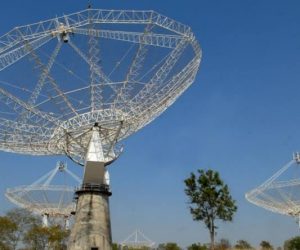NEWS HUNGAMA
Kolkata, January 23, 2023, News Hungama
A radio signal originating from atomic hydrogen in an extremely distant galaxy was detected by the Giant Metrewave Radio Telescope (GMRT) located in Pune. Scientists from McGill University and Indian Institute of Science have made this groundbreaking discovery.
The signal from the star-forming galaxy SDSSJ0826+5630 was emitted when our 13.8 billion-year-old galaxy was just 4.9 billion years old. The signal allowed the astronomers to measure the galaxy’s gas content and find that its mass is double that of the early galaxy’s visible stars.

“The astronomical distance over which such a signal has been picked up is the largest so far by a large margin. This is also the first confirmed detection of strong lensing of 21 cm emission from a galaxy”, according to an IISc statement.
GMRT is a low-frequency radio telescope that helps investigate various radio astrophysical problems ranging from nearby solar systems to the edge of the observable universe.
Atomic hydrogen is the basic fuel required for star formation in a galaxy. When hot ionised gas from the surrounding medium of a galaxy falls onto the universe, the gas cools and forms atomic hydrogen. This then becomes molecular hydrogen and eventually leads to the formation of stars.

However, this radio signal is incredibly weak, making it nearly impossible for present telescopes to detect the emission from a far-off galaxy.
“Until now, the most distant galaxy detected using 21 cm emission was at redshift z=0.376, which corresponds to a look-back time – the time elapsed between detecting the signal and its original emission – of 4.1 billion years (Redshift represents the change in wavelength of the signal depending on the object’s location and movement; a greater value of z indicates a farther object),” it said.


